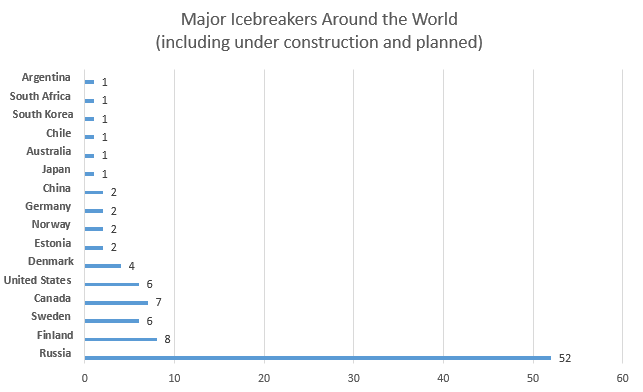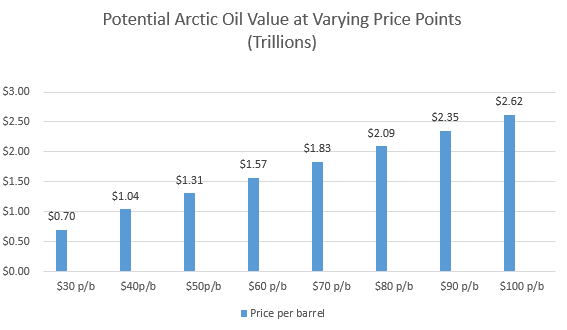Research
June 6, 2016
Icebreakers: Anchors Aweigh
Summary:
- The FY2017 Defense Appropriations Bill allocated $1 billion to construct the first U.S. icebreaker in 25 years.
- The U.S is far behind countries like Russia and China when it comes to icebreaker ownership and construction.
- At today’s price of oil, the estimated Arctic oil potential could total over $1.3 trillion.
All Hands on Deck
Last week, the Senate Appropriations Committee approved the $515.9 billion FY2017 Defense Appropriations Bill, which allocated $1 billion to construct the first U.S. icebreaker since the U.S. Healy was constructed almost 25 years ago. If enacted, this would be a momentous step forward in terms of arctic exploration and will become a crucial tool in future U.S. Arctic policy. It will, however, take approximately 10 years to come to fruition.
High and Dry
For the past two decades, Congress has been resistant to funding Arctic Icebreakers because of the steep costs associated with materials, building and labor hours, and the fact that the Arctic was less appealing than it is today. According to a previous American Action Forum study, “with the exception of the Cold War, the United States has invested very few resources in order to secure its position as a global leader in Arctic affairs.” This includes icebreakers. As of late, Members of Congress in both the House and Senate have started a campaign to fund these vessels as a measure to keep the U.S. in the running for exploration and as a national security and defense mechanism.
While many companies have postponed arctic drilling, countries such as China and Russia are racing to start exploration and are expanding their fleets of icebreakers. In January, China commissioned its latest icebreaker to pursue their interests in the Arctic and Antarctic.[1] Russia is set to launch their newest nuclear icebreaker from St. Petersburg in the next few weeks; it will be the world’s largest and most powerful icebreaker to date.[2] Currently, Russia maintains the world’s largest fleet of icebreakers, 41, with 15 more in pre-planned production. The U.S., according to the U.S. Coast Guard, comes in a meager 6. Only 2 of these are viable to operate and both of which are nearing the end of their intended lifespan. The U.S. icebreaking fleet currently includes one 399-foot heavy icebreaker (Coast Guard Cutter Polar Star, commissioned in 1976) and one 420-foot medium icebreaker (Coast Guard Cutter Healy, commissioned in 2000 and funded in the FY1990 Defense Appropriations Act). These cutters are designed for open-water icebreaking and feature reinforced hulls and specially angled bows.
According to a Congressional Research Service study, there are 98 major icebreakers around the world (including ships that are under construction and planned), with more than half being accounted for by Russia. A breakdown by country is below:
Source: CRS https://www.fas.org/sgp/crs/weapons/RL34391.pdf
The U.S. Coast Guard, which has jurisdiction over the icebreaking fleet, has said that it would need at least 6 ships to support the Arctic and Antarctic missions. This would come with a very steep price tag; at least $6 billion.
The Prize
The U.S. is one of five countries with territorial claims to the land and waters of the Arctic. The others are Canada, Russia, Denmark, and Norway. It is estimated that a quarter of the worlds undiscovered oil and gas could potentially be housed in the Arctic. According to a previous American Action Forum research study, that figure comes close to over 26.21 billion barrels of recoverable oil. At today’s price of oil at just under $50 per barrel would equal around $1.3 trillion. The following chart shows the potential Arctic oil value at different price points.
Conclusion
It is in the United States’ best interest to continue funding arctic icebreakers. In addition, it is imperative that the U.S. be allowed to explore and develop a region it has claim to. Holding back funding and barring development sets the U.S. back and weakens North American resource development and defense. The U.S. cannot afford to let unfriendly countries such as China and Russia take the lead on arctic exploration and development.
[1] http://www.popularmechanics.com/military/weapons/news/a18867/china-launches-new-icebreaker/
[2] http://arctic.ru/infrastructure/20160531/369379.html












